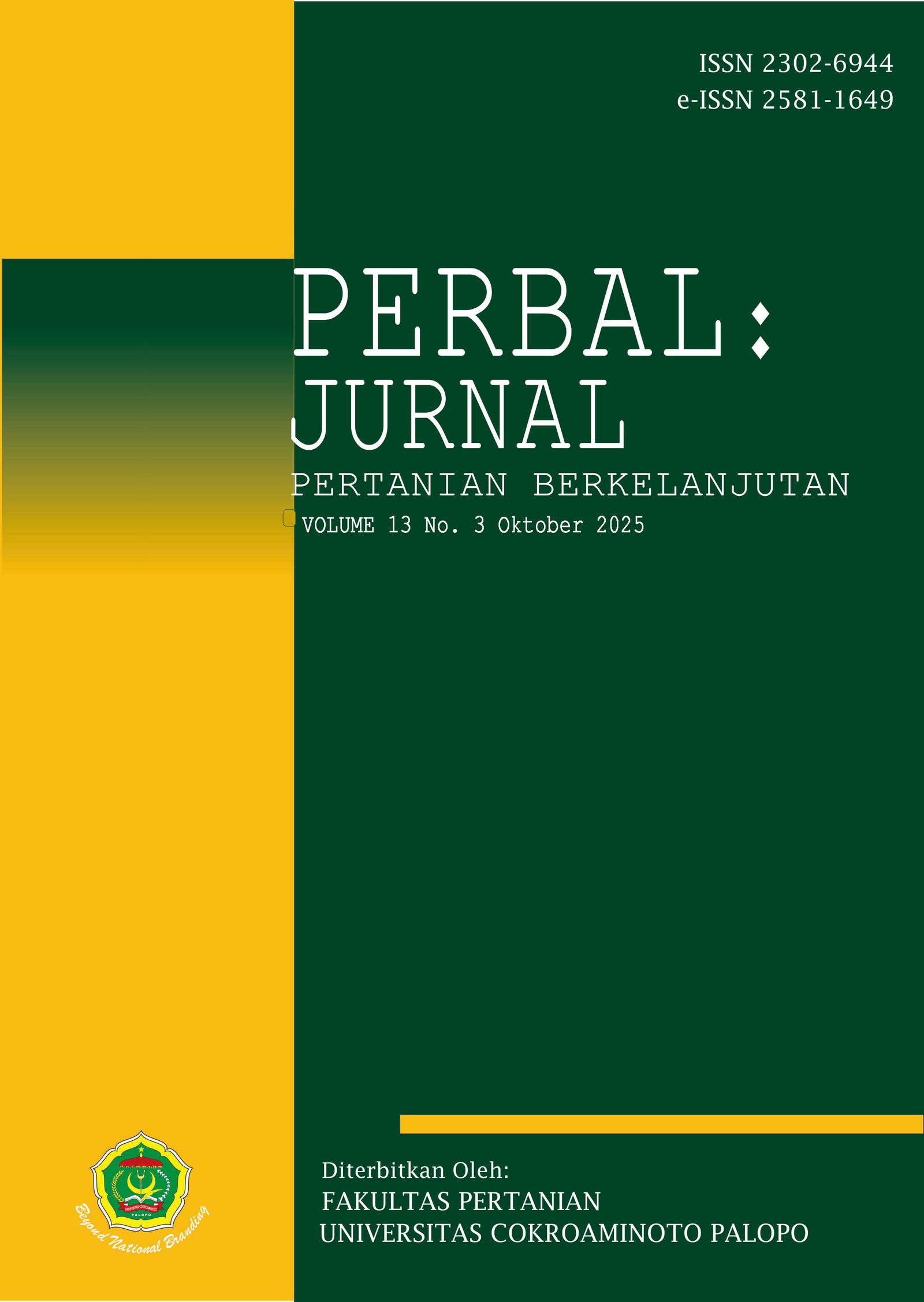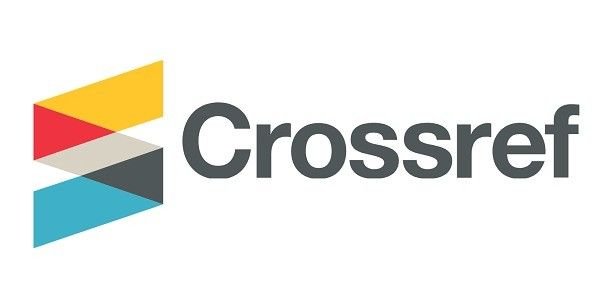Keanekaragaman dan Dominansi Gulma pada Fase Kritis Tanaman Jagung di Kecamatan Taluditi Kabupaten Pohuwato
Weed Diversity and Dominance in the Critical Phase of Corn Crops in Taluditi District Pohuwato Regency
DOI:
https://doi.org/10.30605/perbal.v13i3.6816Keywords:
Dominansi, fase kritis, gulma, jagung, produksiAbstract
Keberadaan gulma menjadi masalah penting dalam budidaya tanaman. Semakin lama gulma tumbuh bersama dengan tanaman pokok, semakin hebat persaingannya, pertumbuhan tanaman pokok semakin terlambat, dan hasilnya semakin menurun. Tujuan dari penelitian ini sebagai berikut : (1) untuk mengetahui gulma apa saja yang tumbuh dan mendominasi pada fase kritis sehingga pengendalian dapat dilakukan secara efektif dan dapat mencegah persaingan di pertanaman jagung di Kecamatan Taluditi Kabupaten Pohuwato, (2) Untuk mengetahui indeks keanekaragaman gulma yang tumbuh pada areal pertanaman jagung. Metode yang digunakan dalam penelitian ini adalah metode kualitatif (mendeskripsikan dan mengidentifikasi gulma yang ditemukan pada pertanaman jagung) dan kuantitatif (menghitung dan menganalisis vegetasi gulma yang dominan serta keanekaragaman pada pertanaman jagung). Tahapan penelitian yaitu survei lokasi, pengumpulan data (observasi lapang, pengambilan sampel dan identifikasi, wawancara, dokumentasi), analisis dan pengolahan data. Adapun analisis data yang dilakukan yaitu analisis data kerapatan mutlak, kerapatan nisbi, frekuensi mutlak, frekuensi nisbi, nilai penting, Summed Dominance Ratio (SDR) dan indeks keanekaragaman jenis (H’). Berdasarkan hasil yang didapatkan dilapangan terdapat 26 jenis gulma yang terdapat dalam lahan pertanaman jagung sebagai sampel penelitian. Gulma yang mendominasi lahan pertanaman jagung fase kritis umur 20-25 HST adalah rumput teki (Cyperus rotundus) sebesar adalah 46,8 %, sedangkan gulma yang mendominasi pada lahan pertanaman jagung pada fase kritis umur 45-50 HST adalah gulma rumput kelabang (Eremochloa ophiuroides) sebesar 31,4%. Indeks keanekaragaman gulma yang terdapat pada pertanaman jagung pada fase kritis umur 20-25 HST dan Umur 45-50 HST berkisar pada nilai 1.9184-2.2611, termasuk dalam kategori sedang.
The presence of weeds is a significant problem in crop cultivation. The longer weeds grow alongside the main crop, the greater the competition, the slower the main crop's growth, and the lower its yield. The aims of this research are as follows: (1) to find out which weeds grow and dominate in the critical phase so that control can be carried out effectively and can prevent competition in corn plantations in Taluditi District, Pohuwato Regency, (2) to find out the diversity index of weeds growing in corn plantation areas. The methods used in this research are qualitative methods (describing and identifying weeds found in corn plantations) and quantitative methods (calculating and analyzing dominant weed vegetation and diversity in corn plantations). The research stages are location survey, data collection (field observation, sampling and identification, interviews, documentation), data analysis and processing. The data analysis carried out included analysis of absolute density data, relative density, absolute frequency, relative frequency, important value, Summed Dominance Ratio (SDR) and species diversity index (H'). Based on the results obtained in the field, there were 26 types of weeds found in the corn plantations as research samples. The weeds that dominate the critical phase of corn planting land at 20-25 HST are nutsedge (Cyperus rotundus) at 46.8%, while the weeds that dominate the critical phase of corn planting land at 45-50 HST are centipede grass (Eremochloa ophiuroides) at 31.4%. The weed diversity index found in corn plantations at the critical phase of 20-25 HST and 45-50 HST ranges from 1.9184 to 2.2611, which is included in the moderate category.
Downloads
References
Abdi, Z., Ja. S., & Agusman, H. (2024). Pengaruh sistem jarak tanam dan metode pengendalian gulma terhadap pertumbuhan dan produksi jagung (Zea mays L. ). Jurnal Serambi Konstruktivis 6(2), 56-64.
Afrianti, I., Yolanda, R., & Purnama, A.A. (2014). Analisis Vegetasi Gulma pada Perkebunan Kelapa Sawit (Elaeis quinensis Jacq.) di Desa Suka Maju Kecamatan Rambah Kabupaten Rokan Hulu. Universitas Pasir Pengaraian.
Assa, K.S.A., Tumewu, P., & Tulungen, G. (2017). Inventarisasi Gulma Pada Tanaman Jagung (Zea mays L.) Dataran Tinggi di Desa Palelon dan Dataran Rendah di Kelurahan Kima Atas. Budidaya Pertanian. Fakultas Pertanian. UNSRAT Manado.
Cholid. (2014). Jenis dan dominansi gulma pada lahan jagung manis (studi kasus di Kecamatan Tobelo). Jurnal Agroforestri Politeknik Perdamaian Halmahera Tobelo, 8(2), 75–82.
Erse D.P & Arsyad, M. (2018). Keanekaragaman dan dominasi gulma pada pertanaman jagung di lahan kering Kecamatan Marisa Kabupaten Pohuwato. Agrovigor: Jurnal Agroekoteknologi, 11(2), 71-76. DOI: https://doi.org/10.21107/agrovigor.v11i2.4291
Fitrawati, Ilsan, M., Rasyid, R. (2023) Analisis ekonomi dan prospek pengembangan usaha tani jagung (studi kasus di Desa Lalabata, Kecamatan Tanate Rilau) WIRATANI: Jurnal Ilmiah Agribisnis, 6(2), 138- 146. DOI: https://doi.org/10.33096/wiratani.v6i2.307
Hidayat, A. Lumbanraja, J., Utomo, S. D., dan Pujisiswanto, H. 2017. Respon Tanaman Jagung (Zea mays L.) terhadap Sistem Olah Tanah pada Musim Tanam Ketiga di Tanah Ultisol Gedung Meneng Bandar Lampung. Jurnal Agrotek Tropika, 6(1), 1-7. DOI: https://doi.org/10.23960/jat.v6i1.2525
Kastanja, A.Y., Patty, Z., & Dilago, Z. (2021). Weed diversity in upland rice area in west Tobelo, North Halmahera, Indonesia. International Journal of Botany Studies, 6(3), 724–729.
Mahriyah, Saylendra, A., Putri, W.E., Rohmawati, I. (2024). Analisis vegetasi gulma pada pertanaman jagung (Zea mays L.) fase vegetatif di Kecamatan Cipocok Jaya Kota Serang. Jurnal AgroSainTa, 8(2), 111-120.
Ngawit, I.K., & Fauzi, M.T. (2021). Periode kritis jagung manis berkompetisi dengan gulma pada entosil Lombok Tengah. Jurnal Sains Teknologi & Lingkungan, 32-43. DOI: https://doi.org/10.29303/jstl.v0i0.248
Opa, N.B., Petronella, S.N., Agustina, E.N., Agnes, V.S., Diana, S.S., Max, J.K., Agustina, E.N., Mudita, I.W., & Yeni, R.K. (2022). Analisis keragaman gulma pada tanaman jagung di kelompok tani usaha maju, Desa Naibonat, Kecamatan Kupang Timur, Kabupaten Kupang. Jurnal Wana Lestari, 4(2), 366-373. DOI: https://doi.org/10.35508/wanalestari.v7i02.9465
Pribadi, A., & Anggraeni, I. (2010). Jenis dan struktur gulma pada tegakan di lahan gambut (studi kasus pada HPHTI PT Harara Abadi, Riau). Jurnal Tekno Hutan Tanaman, 4(1), 33–40.
Sembodo, D.R.J. (2010). Gulma dan Pengelolaannya. Graha Ilmu. Yogyakarta.
Suryaningsih, Joni, M., & Darmadi, A.A.K. (2011). Inventarisasi gulma pada tanaman jagung (Zea mays L.) di lahan sawah Kelurahan Padang Galak, Denpasar Timur, Kodya Denpasar, Provinsi Bali. JURNAL SIMBIOSIS, 1(1), 1-8.
Umiyati, U., & Widayat, D. (2017). Gulma & Pengendaliannya. Yogyakarta: Deepublish.
Downloads
Published
Issue
Section
License
Copyright (c) 2025 Muh. Arsyad, Erse Drawana Pertiwi, Roy Jordi Masjid

This work is licensed under a Creative Commons Attribution 4.0 International License.
In submitting the manuscript to the journal, the authors certify that:
- They are authorized by their co-authors to enter into these arrangements.
- The work described has not been formally published before, except in the form of an abstract or as part of a published lecture, review, thesis, or overlay journal.
- That it is not under consideration for publication elsewhere,
- That its publication has been approved by all the author(s) and by the responsible authorities – tacitly or explicitly – of the institutes where the work has been carried out.
- They secure the right to reproduce any material that has already been published or copyrighted elsewhere.
- They agree to the following license and copyright agreement.
License and Copyright Agreement
Authors who publish with Onoma Journal: Education, Languages??, and Literature agree to the following terms:
- Authors retain copyright and grant the journal right of first publication with the work simultaneously licensed under Creative Commons Attribution License (CC BY 4.0) that allows others to share the work with an acknowledgment of the work's authorship and initial publication in this journal.
- Authors are able to enter into separate, additional contractual arrangements for the non-exclusive distribution of the journal's published version of the work (e.g., post it to an institutional repository or publish it in a book), with an acknowledgment of its initial publication in this journal.
- Authors are permitted and encouraged to post their work online (e.g., in institutional repositories or on their website) prior to and during the submission process, as it can lead to productive exchanges, as well as earlier and greater citation of published work.














